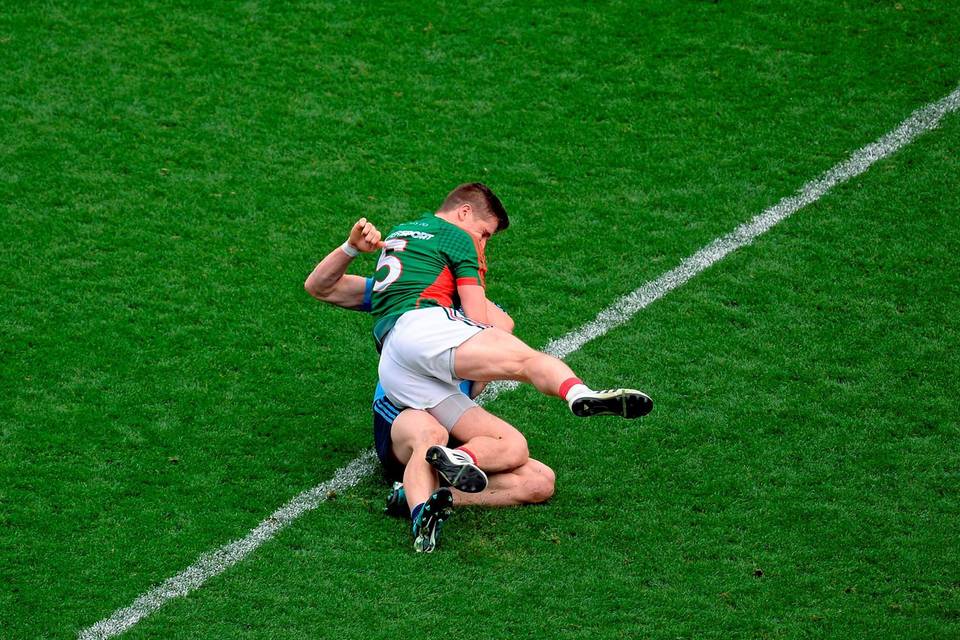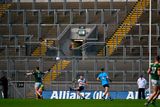'Off-the-ball incidents are deeply depressing and corrosive to the game of football'
Lee Keegan and Diarmuid Connolly tussle in an incident which eventually saw Connolly sent off
Here's what the GAA president said: "You would hope that at least one of the seven officials on duty would see off-the-ball incidents but, unfortunately, it does not always work out that way."
And here's his solution: "If we have cameras keeping an eye on what is happening, the small minority of players who indulge in off-the-ball intimidation will surely change their attitude."
And so emerged the proposal to instal special cameras in Croke Park which would scan the entire pitch, rather than follow the play. Undetected nefarious deeds perpetrated away from the point of action would be dealt with later.
No, the speaker wasn't current president Aogán O Fearghaill, but one of his predecessors, Dr Mick Loftus.
It's all of 29 years since those comments were made in an interview I conducted with Dr Loftus, GAA president in 1985-88.
Off-the-ball incidents were the hot issue of the time, and since TV coverage didn't have anything like the number of cameras used nowadays, it picked up very little away from the immediate action.
So when Mayo wing-back John Finn had his jaw broken in an off-the-ball incident against Dublin in the drawn 1985 All-Ireland semi-final, the offence went unpunished, despite an investigation.
Culprit
That a player suffered such a serious injury in front of 40,295 people without the culprit being identified, dismayed Dr Loftus, prompting his camera proposal.
It never came to fruition, presumably after failing some practicality test when the logistics were scrutinised.
Thirty years later, there are enough cameras in Croke Park to detect a mouse scuttling in the shadows at the dead of night.
Yet, for all the technology, misdemeanours are as common now as then. The texture is different but the trend is even worse.
Last Sunday's semi-final was a typical example. It featured two of the three most talented teams in the country yet they opted for a niggly, mean-spirited approach.
Part of Dublin's response to the threat of Aidan O'Shea's new role as a powerhouse attacker was to foul him repeatedly off the ball, jersey-tugging and obstructing him before he began a run.
It's all but impossible for a referee, who can be a long way off, to spot that type of offence on a consistent basis. And since umpires and linesmen can only draw his attention during a break in play, the moment passes.
Interestingly, referee Joe McQuillan penalised Dublin for fouling O'Shea off the ball just after half-time. It was no different to what had happened earlier so why the change? Did it arise from a conversation between McQuillan and his officials at half-time?
O'Shea's patience was admirable as it would have been easy to react. As for Philly McMahon's head gesture in his direction, TV replays showed that it looked worse than it really was. Still, with referees making calls in real time, McMahon could have had no complaints if he had been dismissed.
O'Shea wasn't the only one 'getting the treatment'; in the case of Diarmuid Connolly, it worked eventually as he was sent off. Clearly, it was in Mayo's interest for Lee Keegan to 'detain' Connolly on the ground in a tussle, since it kept one of Dublin's best forwards out of the action.
Connolly lashed out and was dismissed while Keegan, probably the guiltier party in starting the incident, got off on yellow. That's the rule, but how fair is it?
Cillian O'Connor was lucky too to escape sanction for the incident which forced Rory O'Carroll out with a serious facial injury early on. But then, Carroll's marking style is close enough to the edge to attract the occasional outbreak of retribution.
This type of borderline stuff now appears to be endemic in the approach taken by most teams.
It's all deeply depressing. Thirty years ago, the main problem related to an inability to detect off-the-ball incidents. Modern cameras solved that but they can't help in the battle against some of the more corrosive practices now infecting the game.
Blaming referees is not the answer. It's easy, but it's missing the point that controlling Gaelic football, as it stands, is beyond the capabilities of any referee. And it will remain so, unless players, managers and coaches change their attitude and allow respect and integrity to breathe.















